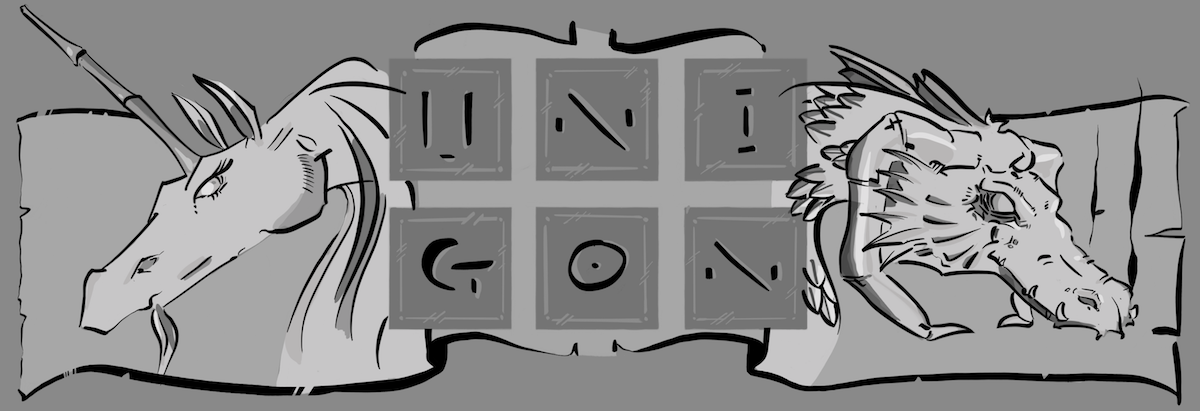One of the great things at Norwescon is in recent years is the addition of an artist workshop, or otherwise a critique of your work by both other artists and folks in the art field such as art directors, collectors, et cetera.
I participated last year for the first time, not entirely knowing what to expect. I found it sufficiently valuable that I wanted to do it again this year. Whereas last year I brought my work on my iPad, this year I had physical copies of my work. First and foremost, I’m now a believer of physical copies, especially given I was honestly a bit skeptical at first. But today I found that having physical copies all laid out on the table really allows for a much more comprehensive view of your work. To boot, I was able to lay out my work in chronological order, allowing us to find subtle shifts in my technique or approach that had encroached over time, but might otherwise lay undiscovered if viewed serially.
The critique, in no particular order, included the following major themes, or:
- Push Contrast – over time my work has lost its depth due to a flattening of my values. I will admit this was intentional, but that is not to say it was the right decision. One person noted that my earliest piece is the strongest in terms of contrast, and likely a reason many people like it more than others. For what its worth, its the piece I like the least in terms of technique and rendering, so I will definitely go back and re-do, albeit I will try not to lose some of the things that make it stand out for so many others.
- Know Your Profiles – this is a bit of a corollary to comments on contrast. While I know the value of 3-value thumbnails, I’m not as disciplined as I ought to be with it. The use of this technique early in the creation process can help ensure that my primary subjects can be read at a distance, and also help solve some of the muted contrasting that has crept into my work in the past year or so.
- Warm vs Cool – My use of warm versus cool colors is, at times, fighting with the primary focal points. One recommendation is to use cooler colors to help knock back parts of the composition so it better recedes into the background, and use warmer colors to draw the viewer to the primary focal point. Interestingly, my own self-portrait suffers from this where the armor is the place where the viewer’s eye is drawn toward, and not my face itself. Someone asked if this was intentional or otherwise a subconscious decision; honestly, I think I just got carried away as it was the last thing I added and it being the first time I had rendered armor I got a bit carried away.
- Careful of Lighting – In at least one instance, the lighting of my subject was inconsistent. In particular, I rather abused rim lighting to outline the subject. I will readily admit, I recall that at the time of producing that particular piece I had just learned of various forms of lighting, and had become enamored in particular with rim lighting. I’m still enamored; but, hopefully I apply it a bit more logically in the proceeding year since I learned of it.
While not a critique in and of itself, there was at least one compliment that particularly pleased me as an artist. I’ve always been in love with the textures of oils on canvas, and even though I avoid analog approaches, I’ve always wanted my pieces to exist in both worlds. At least one of the persons thought my work was analog (e.g. oils or acrylics) when in fact all my pieces are almost entirely if not entirely digital. As noted, I’ve been striving to achieve a more painterly style, so to have someone note with some surprise that my pieces were indeed digital really tickled me delighted.
From the critiques, there was some solid suggestions and questions that arose. One question is what my goals were as an artist, especially as I have pieces that are both a bit whimsical and other pieces that are more realistically rendered. Especially in context to professional pursuits, I’d really love to eventually illustrate books both as inserts and covers. My whimsical pieces would be appropriate for children’s or YA (young adult) books, whereas some of my other pieces would more appropriate for maturer audiences. In reality, I aspire to do both.
In that context of my goals, a suggestion given was to take one of my pieces and re-interpret for a different audience; I love the idea! It’s a great project, and an opportunity for me to show myself and possible clients my ability to approach a subject that is appropriate to the intended audience.
Another great suggestion is to revisit some of my recent pieces where I’ve dampened my range of contrasts, and push the values to help pull and push the fore- and backgrounds, respectively.
Here is the work reviewed, and presented in general chronological order.







In summary, even if you did nothing but attend these workshops, they are well worth the price of admission to Norwescon. I really appreciate people taking the time to constructively provide feedback; I always leave these feeling greatly inspired and re-invigorated to develop my technical and narrative skills so I continue to grow as an artists.
And to all my critiquers, thank you!


One thought on “Norwescon Artist Workshop”